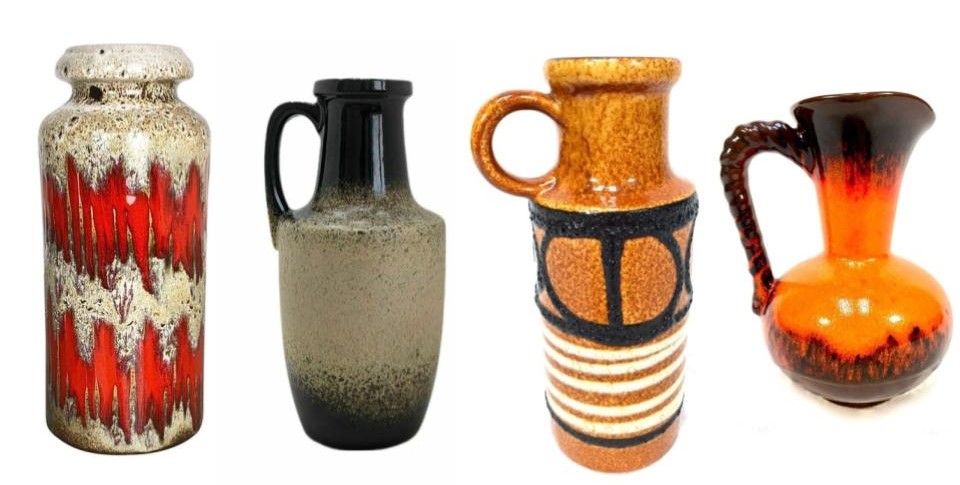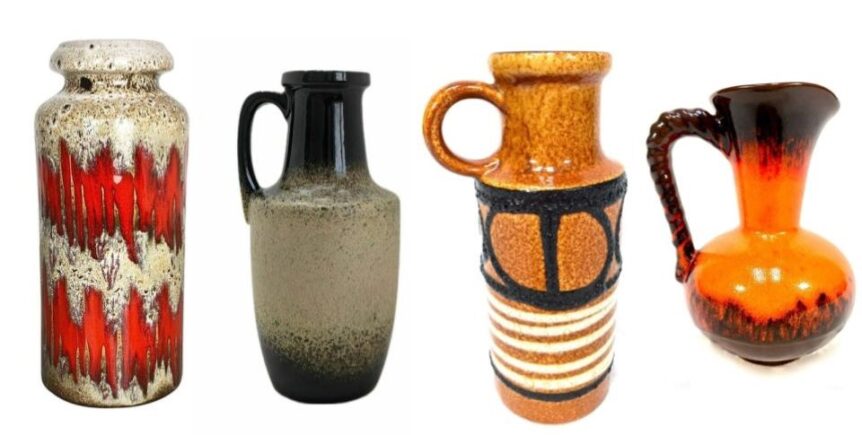The Complete Guide to Identifying Genuine West German Pottery from the 1950s-1980s

West German pottery became hugely popular in the 1950s-1980s due to its high-quality craftsmanship and innovative designs. Many people today seek out these vintage pieces to add character to their homes.
But with a variety of markings and stamps, it can be tricky to identify which pottery was truly made in West Germany during this era.
So how do you spot authentic West German pottery?
There are a few techniques you can use to properly identify real mid-century West German pottery. This includes checking for markings like “Made in Western Germany,” researching the manufacturer’s history, and looking for distinctive styles like Bauhaus-influenced design.
Read on for more details on how to authenticate the origins of vintage West German pottery using signatures, weight, colors, patterns, and other identifying traits. With the right knowledge, you can successfully source quality pieces of this popular pottery.
- Examine any back stamps or markings
The quickest way to identify real West German pottery is to check for markings on the bottom or backside. Authentic manufacturers from West Germany during the 1950s-80s era marked their pieces to indicate the country of origin.
Markings to look for include:
- “Made in Western Germany”
- “Made in West Germany”
- “Made in W. Germany”
- The city of production, such as “Bavaria” or “Karlsruhe”
These stamps confirm the pottery was produced in West Germany during the peak era of popularity. West German makers used such markings consistently at the time to differentiate their pieces from East German and other foreign potteries.
If you don’t see an origin marker, look for the company name stamped on the bottom. You can then research the manufacturer’s history to determine if they made pottery in West Germany during the mid-1900s boom.
- Consider the manufacturer’s backstory
Many reputable West German pottery companies from the 1950s-1980s era are still around today producing high-quality ceramics. Some major names to look for include:
- Villeroy & Boch – Founded in 1748 in Mettlach, Germany
- Hutschenreuther – Producing pottery in Bavaria since 1814
- Rosenthal – Pottery made in Selb, Bavaria since 1879
- Arzberg – Porcelain creations since 1887 in Arzberg, Bavaria
If you find any vintage pottery marked with these German company names, there’s a strong chance it’s authentic mid-century ware. The location and long histories of production undeniably tie them to post-war era West German pottery manufacturing.
Lesser-known names like Carstens, Seltmann Weiden, and Leonhardi are also indicators of true West German pottery origins. Research the histories of any maker’s marks to assess authenticity.
Related articles:
- 10 Best Vintage Danish Furniture Brands of the 1960s and 1970s
- What Wood is Used for Mid-Century Modern Furniture?
- How To Identify Mid-Century Modern Furniture
- How To Identify A Mid-Century Lamp
- Look for distinct West German styles
Certain styles emerged in the 1950s-80s that distinguished West German pottery from other countries. Become familiar with these distinctive design elements to help spot genuine articles:
- Bauhaus-Influenced – The influential Bauhaus art school was located in Germany, so West German potters embraced minimal, geometric forms. Clean lines and simple shapes defined their style.
- Sgraffito – A traditional decoration technique using incised designs and contrasting colored glazes originated in Germany. Spotting this scratch-like pattern points to West German origins.
- Pastel Colors – Unlike the earthy hues used by other countries, West German potters favored lighter pastel shades of yellow, blue, pink, mint, and more. These colors set their pottery apart.
- Whimsical Creatures – West German pottery incorporated charming creatures like birds, forest animals, and mythical figures into their designs. Playful and nature-inspired motifs were common.
- Metallic Accents – Brushed gold, silver, or copper details along the rims and edges of pieces added elegance. This metallic trim emerged as a key West German style.
- Check the weight and feel
Authentic West German pottery feels solid, smooth, and surprisingly heavy in the hand thanks to high-quality materials and expert craftsmanship.
Lift up a piece and run your hands along its finish. It should have an even glaze and well-sanded bottom. Knock gently on the pottery and listen for a light ringing sound. This indicates sturdy porcelain versus cheaper hollow materials.
Substantial weight and precise detailing gives away true German manufacturing. Cheaper imitation pottery tends to feel lighter, uneven, or rough.
Related articles:
- Why Is Mid-Century Furniture So Expensive?
- How To Find Cheap Mid-Century Furniture
- How To Identify A Vintage Or Antique Desk
- Look for signs of age and use
Genuine vintage and antique West German pottery will show some natural signs of age and use rather than looking brand new. Signs of wear may include:
- Faded or worn manufacturer stamps
- Light utensil scratches inside mugs
- Paint color rubbed off on edges
- Minor chips, cracks, or crazing of glaze
Too much damage can diminish value, but normal indications of use suggest authenticity. Be suspicious of pieces in “too perfect” condition, as they are more likely modern reproductions.
Related Questions
Is pottery from West Germany valuable?
West German pottery can be quite valuable, especially pieces from the 1950s-1980s. Key factors that increase value include the manufacturer, style, condition, and rarity.
Some of the most valuable and collectible West German pottery brands include Villeroy & Boch, Rosenthal, Hutschenreuther, Arzberg, and Seltmann. Styles like Bauhaus-inspired designs and sgraffito patterns are also in demand. Perfect condition pieces fetch higher prices, but acceptable crazing and wear is expected in truly vintage items.
Rarer patterns, uncommon colors like bright orange or green, collaborations with renowned designers, and customized celebrity or event pieces have extra value with collectors. Limited edition runs also carry premium pricing.
Researching completed eBay auctions can give you an idea of current market values. In general, quality vintage West German pottery from top brands in good vintage condition can sell for $50-$300 per piece. Exceptional rare finds can sell for even higher.
West German Pottery Makers
Some of the most notable pottery companies that produced in West Germany during the mid-century era include:
- Villeroy & Boch – Founded in 1748 and still thriving today, their Mettlach region pottery is especially prized. Known for stoneware, Art Deco styles, and metallic detailing.
- Rosenthal – Established in 1879 in Bavaria, they focused on quality porcelain dinnerware and figurines. Many collect their whimsical animal designs.
- Hutschenreuther – Producing porcelain in Bavaria since 1814, they embraced a modernistic style. Bold red and black signature patterns are iconic.
- Arzberg – Specialized in ultra-thin eggshell porcelain since 1887 in Germany. Famous for their white & gray polka dot design.
- Seltmann Weiden – Bauhaus-influenced designs defined their offerings from 1911-2013. Clean blue and white lines were a signature.
- Carstens – Ancient Germanic motifs were common in their stoneware crafted since 1820. Rich dark blue glazes created a unique look.
- Leonhardi – Quirky figurines and vases with muted earth-toned glazes were their specialty. Whimsical owl and forest scenes are popular.
Beyond marking and manufacturer, understanding the array of styles and techniques used by West German potters helps identify authentic pieces. Examine all visual clues to confirm origin and value.
Conclusion
With the right knowledge about markings, design styles, and manufacturing traits, you can successfully identify quality West German pottery made from the 1950s to 1980s.
Look for back stamps like “Made in Western Germany,” well-known brand histories, distinctive Bauhaus-inspired shapes, pastel colors, playful creatures, and high-quality construction. Minor age signs confirm vintage authenticity versus new replicas.
Key markers to examine include:
- Manufacturer Marks – Authentic West German pottery will be stamped with the words “Western Germany” or a German city of origin. Company names like Villeroy & Boch and Hutschenreuther confirm German origins.
- Design Styles – Clean modernist lines, sgraffito scratch patterns, pastel glazes, whimsical nature motifs, and metallic accents characterize true West German pottery.
- Weight and Feel – Quality materials give German pottery a smooth glaze, sturdy heft, and ringing sound when tapped. Imitation pottery feels light and uneven.
- Signs of Age – Some fading, crazing, paint wear, and utensil marks indicate authentic vintage vs. new reproductions. But the condition should still be good.
- Rare Patterns and Colors – Uncommon designs and colors like bright greens or oranges increase value for serious collectors.
Thoroughly inspecting all of these elements including markings, weight, styles, colors, age signs, and rare traits allows you to spot true mid-century West German pottery to add to your collection or for resale. Understanding how to properly authenticate and appraise these vintage pieces takes research but ensures you choose genuine quality finds.
By cultivating an eye for key attributes of real 1950s-80s West German pottery, you can confidently build out your collection of this popular vintage ceramic ware.


